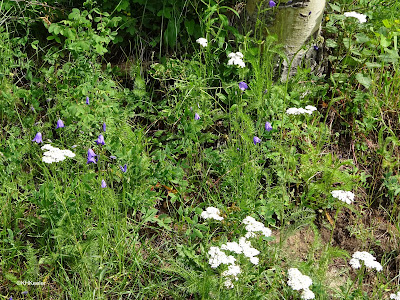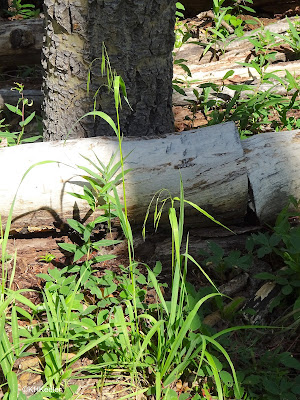In the mountains north of Taos, New Mexico, we hiked the Nordski Trail. It is a trail for cross country/Nordic skiers, including beginners, and so relatively level. We saw lovely vistas and wonderful flowers.
The flowers were particularly abundant at the trail head.
Here are closer looks:
Harebells! I love harebells,
Campanula rotundifolia (harebell family, Campanulaceae; post about them
link). Look! lots of them:
 |
| Harebells (Campanula rotundifolia) and a salsify (Tragopogon) |
The yellow in the photo above is yellow salsify (
Tragopogon, sunflower family, Asteraceae), a weed but a pretty one. (There are two yellow salsifies, I can't tell which this is from the photo; see blog about salsify
link). Furthermore, the open salsify flowerhead--let us imagine the photo is a clue in a mystery story--says the photo was taken in the morning, since salisfy flowerheads close about noon, concealing all the color.
Below, another photo from the open area near the trail head. The white is yarrow (
Achillea millefolium, sunflower family, Asteraceae; post about yarrow
link). I rarely take a good photo of yarrow because the white is so bright and I'm an impatient photographer. Wild yarrow can be reddish or yellowy, but those are less common. The pink-purple is fireweed (
Chamerion angustifolium evening primrose family, Onagraceae
post ); the common name reflects that it often flowers abundantly in the year immediately after a fire.
Purple and white, harebells and yarrow.
The forest was lovely, too.
 |
|
Nordski has a maze of paths. Some that I didn't take led to quite spectacular viewpoints. The paths were well marked for the skiers, making it easy for me to walk only a little way--I'm slow, I keep stopping for plants!--and for my friends to walk a good deal farther.
 |
A big rose bush
(Rosa species, rose family, Rosaceae)
in the forest |
Grasses are generally ignored when looking at wildflowers. But they can be very pretty:
This might well be the weedy smooth brome (Bromus techtorum, grass family, Poaceae) but it is still attactive.
Here is wintergreen flowering, probably liverleaf wintergreen, Pyrola asarifolia (shinleaf family, Pyrolaceae). I don't think I've seen wintergreen since it grew in the woods of my back yard in upstate New York when I was a child, and that was probably a different species of wintergreen. Cool flowers.
 |
| wintergreen, Pyrola |
This hard-to-see white flower is mountain death camas,
Zygadanus elegans (Melanthaceae, false helebore family). It is a tall slender plant with pretty white flowers at the top. It is seriously poisonous; reportedly juice from the root was used by Native Americas of the central Rockies to immobilize fish so they could gather them. I hadn't seen it before.
 |
| mountain death camas, Zigadenus elegans |
A cute little violet
 |
| white violet (Viola species, violet family, Violaceae) |
A beautiful place. Easy walking on lots of different paths, the forest shady and cool, the flowers bright and abundant.
Comments and corrections welcome.
Many of these plants have changed names more than once in the last 50 years; I used the names in Ackerfield. I included plant families, as usual, so if you don't know the plant, you might know some of its relatives.
References
Ackerfield, J. 2015. Flora of Colorado. BRIT Press, Fort Worth, Texas.
Beidelman, L. H., R. G. Beidleman and B. E. Willard. 2000. Plants of Rocky Mountain National Park. Rocky Mountain National Park Association Publisher, Estes Park, CO.
Kershaw, L., A. MacKinnon and J. Pojar. 2017. Plants of the Rocky Mountains. Partners Publishing, Edmonton Alberta.












No comments:
Post a Comment